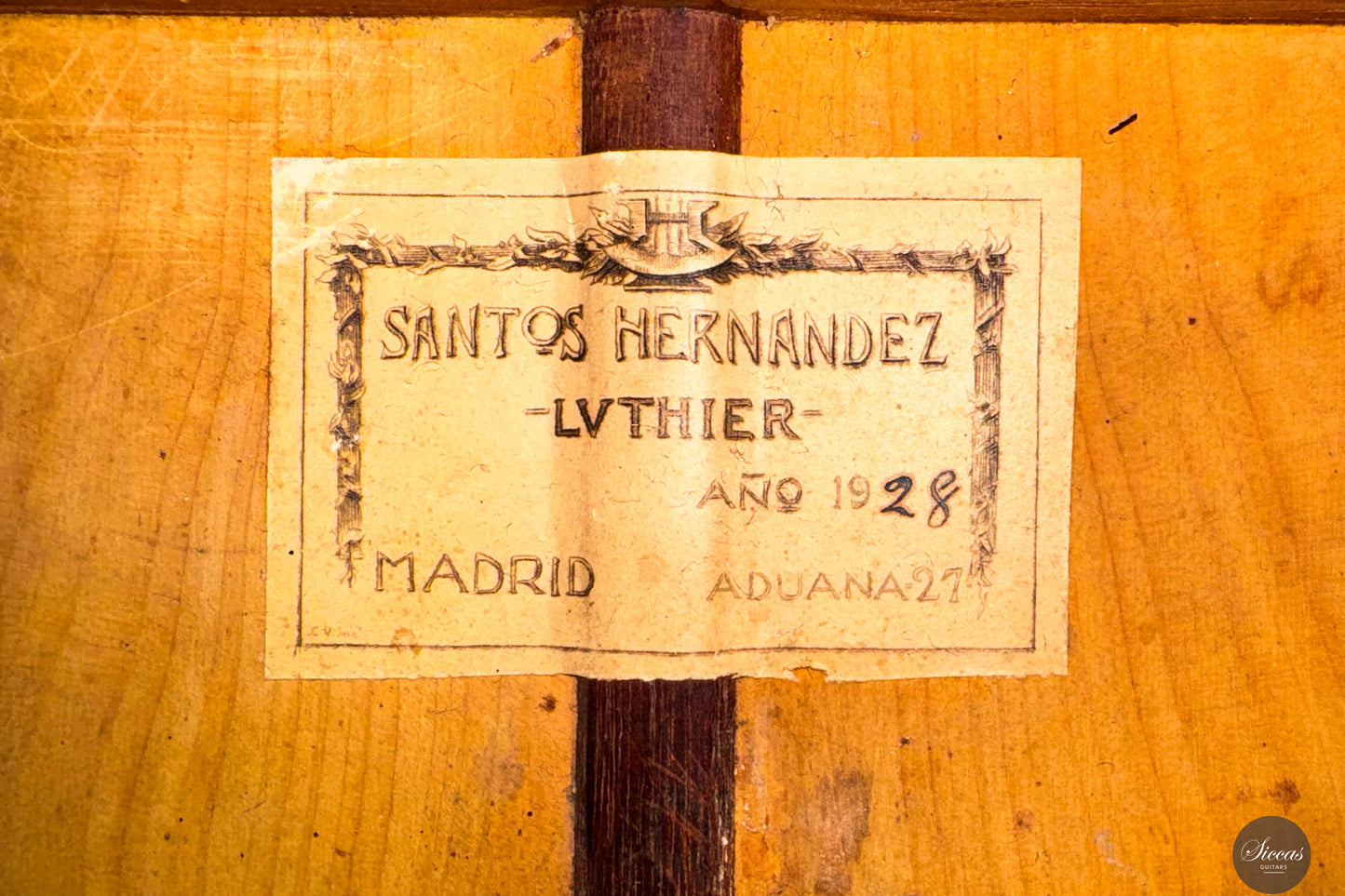Santos Hernandez - 1928 - Flamenca Blanca
Santos Hernandez - 1928 - Flamenca Blanca
Details
Details
Overview
Overview
Shipping important note
Shipping important note
Delivery times are typically reliable and most instruments arrive within the estimated timeframe.
Should any unexpected delay occur, our team will keep you informed and provide support at every step. For all shipping details and exceptions, please see our Shipping Policy.
Details about GPSR
Details about GPSR




















Video overview


More details about the guitar
About the luthier
Santos Hernandez (Madrid, 1873-1943) started an apprenticeship very early in Valentin Viudes’s workshop and then moved to José Ortega’s Granadinian workshop. After moving to a few other workshops and serving as a soldier for Spain, he eventually took over Enrique Garcia’s position in Manuel Ramirez’s workshop in 1905. His involvement in the building of Andrés Segovia’s famous 1912 Manuel Ramirez sealed his reputation as an extraordinary luthier. He opened his first own workshop in 1921 after having worked for Manuel Ramirez’s widow along with Domingo Esteso.About the guitar
This remarkable instrument is nothing short of spectacular—an outstanding creation by one of the greatest guitar makers in history, Santos Hernández. It is a guitar that truly exemplifies why Santos is regarded as a legendary luthier. Lightweight at just a little over 1.1 kg, this guitar responds with breathtaking sensitivity and agility. The basses are deep, airy, and resonate with rich depth, while the trebles are full of personality, singing with warmth and expressive character. Though built as a Flamenca Blanca, this instrument transcends classification and can be played just as beautifully as a classical guitar. As known among connoisseurs, guitars in Santos’ time weren’t rigidly categorized—a guitar was simply a guitar, built for music in its purest form.Condition
The guitar is in amazing condition, especially considering its age. The soundboard has only a few thin cracks near the fingerboard, which are purely cosmetic and do not affect the structure or sound. The back has one well-repaired crack, and the sides feature several well-repaired cracks as well. Overall, the instrument remains in excellent structural and tonal health—a rare and highly collectible masterpiece that performs at the highest level.Regular care extends the life of the instrument
Even with careful use, a classical guitar may gradually change in appearance or respond to unstable storage conditions. Have a close look at your guitar regularly and be attentif to changes. If your instrument is suffering from its environement, it will let you know.
Protect Your Guitar: Handle with Care
Be mindful when touching your instrument with greasy or unwashed hands: any skin contact is a small attack on the varnish. Of course, a guitar is made to be played, but taking a few precautions helps preserve its beauty: wash your hands before playing, wear long sleeves, and avoid unnecessary direct skin contact with the body of the instrument.
Pro tip: Avoid playing with a button-up shirt, heavy jewelry, or a belt, as these can scratch the guitar. Also, make sure your guitar case is free of any objects that could damage the instrument during storage.
String care
A good habit to adopt is wiping down your strings briefly after each playing session. This small action significantly extends their lifespan and helps maintain a consistent, comfortable feel under your fingers.
Most importantly, clean strings are essential for keeping your instrument in tune. Corrosion, sweat, and dust can affect the uniformity of the strings and interfere with accurate tuning across the entire fingerboard.
Pro tip: If you're having trouble getting your guitar in tune, it might be time to change the strings. A useful test is to compare the pitch of the 12th fret harmonic with the fretted note at the 12th fret; if there's an unusually large gap between them, your strings may have lost their integrity and should be replaced.
Keep Your Shellac Finish Shining!
Got a guitar with a shellac (French polish) finish? Here's a simple trick: Take a clean microfiber cloth and gently breathe on the surface to create a light mist. Then, softly rub to remove fingerprints, sweat, and grease. That’s usually all it takes to keep it looking great, no products needed!
Pro tip: Every few years, treat your guitar to a check-up with a luthier to keep it in top shape.
Storing Your Guitar: Climate Matters
Your guitar can safely stay outside its case, as long as the surrounding environment maintains 42–55% humidity and a temperature between 18–25°C.
Keep in mind that humidity levels can still fluctuate inside the case, especially during seasonal changes.
- Too much humidity may cause overtightened strings and a dull tone.
- Too little humidity can lead to a bulging top, string buzz, or even cracks.
Avoid placing your guitar near radiators, air conditioners, or windows with direct sunlight.
Pro tip: Always close your guitar case while playing. This helps preserve a stable microclimate inside the case, so your instrument is protected the moment you put it back in.

















































